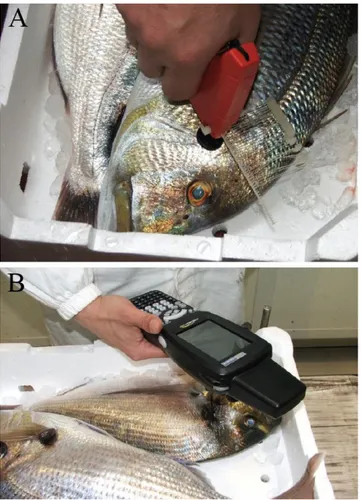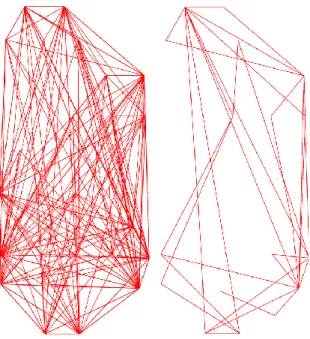Versatile application of RFID technology to commercial and laboratory research
contexts: fresh fish supply-chain and behavioural tests
Corrado Costa1, Jacopo Aguzzi2, Paolo Menesatti1, Antoni Mànuel3, Clara Boglione4, David Sarriá3, José Antonio García2, Francesc Sardà1, Joaquin del Río3, Francesca Antonucci1, Valerio Sbragaglia2,
Massimo Rampacci5, Roberto D’Ambra5, Stefano Cataudella4
1 CRA-ING (Agricultural Engineering Research Unit of the Agriculture Research Council), Via della Pascolare, 16-00015
Monterotondo (Rome), Italy
2 Instituto de Ciencias del Mar (ICM-CSIC), Paseo Marítimo de la Barceloneta, 37-49, 08003 Barcelona, Spain 3 SARTI Research Group. Electronics Dept. Universitat Politècnica de Catalunya (UPC). Rambla de la Exposición 24,
08800 Vilanova i la Geltrú-Barcelona, Spain
4
Dipartimento di Biologia, Università degli Studi di Roma “Tor Vergata”, via della Ricerca Scientifica snc, 00133 Rome, Italy
5 A.Ge.I. Soc. Coop. Rome, Italy Abstract – RFID is an innovative information technology that
potentially allows attaining massive amounts of data. It can be used for traceability of goods trough the different stages of the production chain, as well as in behavioural sciences to track different animals within a group. In this work we provide two examples related to commercial and behavioural study sectors. We firstly applied RFID technology to edible goods supply chain. That application consisted in using tags along the high commercial value supply-chain of fresh fish. The second application consisted in the tracking of behavioural locomotor activity in commercially important crustaceans. In the laboratory, a microcosm tank was endowed with set of RFID controllers below it, each handling group readers in order to contemporarily track four Norway lobsters (Nephrops norvegicus).
Keywords – RFID, Fish supply-chain, Laboratory applications, Nephrops norvegicus, Burrowing rhythms
I. INTRODUCTION
RFID is an innovative ICT tool that allows attaining massive amounts of data in productive commercial sectors such as for example supplies, inventory, customer service, and machinery. Basic RFID system is composed by an antenna, an integrated circuit, a reader that gathers information from the id tag, and finally by a database system that is used to store the information gained through interrogating the id tag [1]. RFID technologies have gained significant interest for supply-chain industries and academics in recent years [2]. Tags advantage consists in its memory storage capacity, saving data in relation for example to the product identification number, price, cost, characteristics, manufacture date, location, and inventory on hand. The traceability of fresh food, such as fish has become a challenging and important aspect in order to keep freshness and costumers safety. Due to a high number of
product variants, strict traceability requirements and the need for temperature control in the supply chain are therefore crucial aspects [32].
RFID technology can be also used to quantify several traits of animals’ behaviour, with potential application to marine organism of
commercial interest. Presently, laboratory
applications are scant for technical difficulties of propagating radio waves within the marine medium.
Although the RFID is an ICT well developed tool, its potential applications has to be investigated inside specific niche sectors in terms of efficiency and economic sustainability. In this context, we tested the RFID technology in two very different sectors: the fresh fish supply-chain and in the laboratory, with behavioural tests on groups of commercially important crustaceans (i.e., the Norway lobster, Nephrops norvegicus).
II. MATERIALS AND METHODS
The application of RFID technology was experimented on the fresh fish supply-chain (Fig. 1). A total number of 8 fish (> 1.5 kg each) of five different species of high economic value
(i.e., Merluccius merluccius, Euthynnus
alletteratus, Dentex dentex, Sparus aurata, Trigla lucerna) was tagged on the operculum and followed along the supply chain. The tags used operated at 13.56 MHz with unique identification data and rewritable memory.
Testing time (h)
Figure 1: A. Application of a RFID tag on the operculum of Sparus
aurata. B. Inquiring RFID tag at the local fish market.
The information (i.e., time, place, species) linked to each single fish/tag was recorded along the supply-chain on the fishing boat, local fish market and fish shop (Fig. 2). An encoding and inquiring unit for RFID tags (Psion Teklogix WorkAbout Pro G2) and a desk read/write unit (MB50) linked to a portable PC via USB were used.
Laboratory tests were conducted within a microcosm tank (150 x 70 x 30 cm) recreating the habitat medium of Nephrops. A distributed system made by 6 controllers each receiving the signal of seven antennas was placed below the tank bottom and connected to a PC storing the spatial information on animals positioning by minute. Four adults were tagged on their telson by a passive RFID transponder (13.56 MHz). Animals were exposed to 12-h light-darkness cycle (10 Lux).
III. RESULTS AND DISCUSSION
The application of passive RFID tags on fish opercula evidenced the necessity to engineer a
specific system to tag fish of large size in an easier and firm way. Along all the supply-chain, tags were always readable. Difficulties of reading were found in relation with the proximity of tags with readers. Archived information in a database resulted efficient and useful also for a potential evolution through a shared web-based system with all the supply-chain (Fig. 2). The economic sustainability resulted positive for fish with high commercial value.
Figure 2: Software interface: the upper side represents the read/write part of the database. The lower part represents the query on database (i.e. the
supply chain).
In relation to behavioural tracking of Nephrops specimens, we could follow their movement as displaced centimetres by unit of time, through days in an individualized fashion (Fig. 3). We observed a variable nocturnal activity across days in some of the tested animals.
Figure 3: Time series of RFID locomotor data reported during 8 consecutive days for two individuals as an example.
Animals’ movements could be also traced to space in a continuous fashion (Fig. 4).
Figure 4: Displacement trajectories reported for two individuals as an example (i.e. those of Figure 3) during 8 days of testing. The developed RFID system allowed tracking
behavioural rhythms at a resolution of
centimetres. Its distributed topology design offered great flexibility, allowing the potential for an easily surface expansion if needed, by simply connecting to the USB ports new controllers with antennas.
IV. ACKNOWLEDGEMENTS
This work was funded by the projects “Sistemi innovativi per la tracciabilità della filiera ittica” (DM 2278 – 29/12/2006) from the Italian Ministry of Agricultural, Food and Forestry Politics and Laboratory developments were funded by the Spanish Ministry of Science and
Innovation (MICINN; NORIT Project,
CTM20055-02034/MAR). Dr. Jacopo Aguzzi is a Fellow of the Ramon y Cajal Program (MICINN). Part of this work is the result of the stage of Dr. Corrado Costa at the ICM-CSIC (Barcelona – Spain).
V. REFERENCES
[1] Roberts, C. M. (2006). "Radio frequency identification (RFID)." Computers & Security 25(1): 18-26.
[2] Sarac A, Absi N, Dauzère-Pérès S, 2010. A literature review on the impact of RFID technologies on supply chain management. Int. J. Production Economics, 128:77–95.
[3] Tingman W, Jian Z, Xiaoshuan Z., 2010. Fish product quality evaluation based on temperature monitoring in cold chain. African Journal of Biotechnology, 9(37): 6146-6151.

